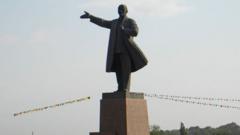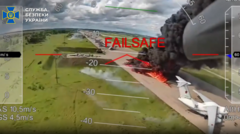In a noteworthy development reflecting the changing societal values in Central Asia, Kyrgyzstan has dismantled a monumental statue of Vladimir Lenin, believed to be the tallest in the region. Standing at an impressive 23 meters, the statue has been a fixture in Osh for five decades, ever since its installation during the Soviet era. Photographs shared over the weekend revealed Lenin’s figure reclining on the ground, having been carefully lowered by a crane.
Kyrgyzstan Removes Iconic Lenin Statue Amid Identity Shift

Kyrgyzstan Removes Iconic Lenin Statue Amid Identity Shift
Kyrgyzstan's removal of Central Asia's tallest Lenin statue marks a significant cultural shift as the nation seeks to redefine its post-Soviet identity.
This removal aligns with a broader trend in several former Soviet republics where there is a growing endeavor to reshape national identities by reducing reliance on Soviet-era symbols and figures. Despite this, local officials in Kyrgyzstan appeared to downplay the significance of the statue's removal, framing it as a routine action intended to enhance the city's "architectural and aesthetic appearance." They linked their decision to similar actions in Russia, where Lenin statues have also been taken down.
Given Kyrgyzstan's delicate relationship with Russia, particularly after the unveiling of a new Stalin statue in Moscow just a week prior, the authorities must navigate the political ramifications of such cultural shifts carefully. For the city of Osh, officials asserted that in place of Lenin, a flagpole would be erected, reflecting a symbolic transition from Soviet remnants.
Since gaining independence 34 years ago following the dissolution of the Soviet Union, Kyrgyzstan has seen numerous reminders of its Soviet past, from monuments to geographic names like Lenin Peak, which remains a significant site within the country. The shift away from such symbols potentially reflects a larger movement toward local identity and a scenario where the influences of history and present political constraints are carefully balanced.
Given Kyrgyzstan's delicate relationship with Russia, particularly after the unveiling of a new Stalin statue in Moscow just a week prior, the authorities must navigate the political ramifications of such cultural shifts carefully. For the city of Osh, officials asserted that in place of Lenin, a flagpole would be erected, reflecting a symbolic transition from Soviet remnants.
Since gaining independence 34 years ago following the dissolution of the Soviet Union, Kyrgyzstan has seen numerous reminders of its Soviet past, from monuments to geographic names like Lenin Peak, which remains a significant site within the country. The shift away from such symbols potentially reflects a larger movement toward local identity and a scenario where the influences of history and present political constraints are carefully balanced.






















